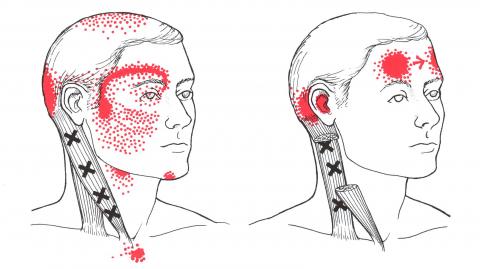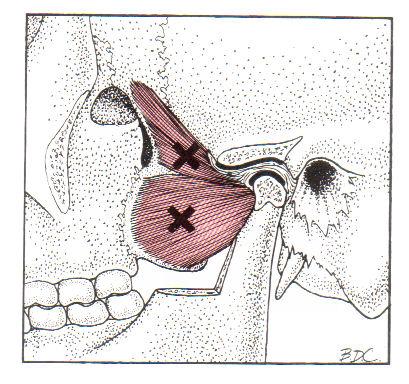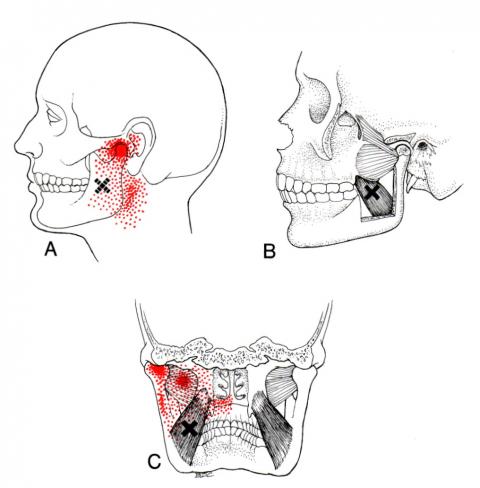Jaw and Face Pain – What else could be the cause when the dentist and doctor say it is not my sinuses, teeth or jaw joint?
Pain around the jaw area can be caused by many things, a problem in the jaw joint (Temporomandibular joint/TMJ) itself, which is often caused by physical trauma, clenching or grinding of the teeth and even stress. Yes, your dental professional can often tell if you clench or grind even if you do not know you are doing it.
Sometimes there are problems with the teeth, nerves, abscess/infection or damage to the disc in the TMJ that cause pain also. If your dental professionals have ruled out these more serious conditions, they are often at a loss as to the cause. The actual cause of the pain that is very often missed is the pain that is referred from myofascial trigger points in the muscles near and attached to the jaw.
There are many muscles that can refer pain to the facial area. Trigger points are so common that the possibility of them being the cause of the pain or dysfunction should be addressed early in the process of looking for the cause, not after everything else has been tried.
"Myofascial trigger points are unbelievably common, yet commonly overlooked ." — David G. Simons, MD Pioneer, researcher and leading expert in the field of pain management.
Thinking to look at the pain patterns, and searching for the offending muscle can save frustration, time and lots of money. Of course being evaluated and treated by a well trained myofascial trigger point therapist (link to NAMTPT) is the best way to find, treat and eliminate them.
What are trigger points?
First, YES they are real! Trigger points are described as hypersensitive spots in skeletal muscle that are associated with palpable nodules (knots) in taut bands (ropes) of muscle fibers. Active Trigger points are a very common cause of pain, which can be mild to annoying to quite severe and even debilitating. Because there are so many events that cause trigger points to be created and to come back, almost everyone has some if not many! Poor posture, injuries and repetitive motion/movement are among the most common ways to create, activate and perpetuate them.
Compression of a trigger point will elicit mild to exquisite local tenderness, usually recreate the referred pain, and often elicit a local twitch response. The local twitch response can be often be seen and felt as a small twitch in the muscle.
Trigger points have well documented, identified, reliable, repeatable referred pain patterns, allowing trained practitioners to associate pain in one location with trigger points elsewhere, sometimes rather distant from the trigger point itself.
The myofascial trigger points often totally explain the “unexplained pain” that frustrates the victim, those close to them and the medical professions. The pain can be mild to severe, can change by the hour or the day, “move around”, usually gets worse if the offending muscles are “over used”, will often reduce with rest and can be “recurrent”, but can also become chronic.
So, lets look at which trigger points can refer to the area of the jaw and cheek? Here are a few of the most common offenders.
The Sternocleidomastoid muscle (SCM)

SCM is a strap of muscle that is located in side and front of the neck, it stands out in some people and is easy to see. This muscle stabilizes the head, side bends to one side while rotating the head to the other and also to bend the head forward.
The SCM muscle and several others are extremely likely to be injured when in a rear end collision as the head is thrown forward and back, hopefully into the headrest. Other “whiplash” injuries can happen in sports and other sudden whipping forward and back of the head. This muscle is shortened when your head is held in a head forward posture. In the asthmatic or patient suffering from emphysema and other chronic breathing difficulties, their SCMs will be over developed and tight as this muscle and the scalenes can be used to assist breathing by elevating the ribs.
The 2 divisions of the muscle refer distinct pain patterns from active trigger points. The patterns of referral are several areas of headache, around and above the eye area, around the temple and to the cheek/jaw/TMJ area and the skull behind and in the ear. Also this muscle can cause pain and odd symptoms in many seemingly unrelated areas, the chin, chest and under the jaw, postural dizziness and imbalance, face/sinus pain and even earache and eye symptoms such as blurred or double vision and odd visual perception such as feeling like you are still moving when stopped.
The lateral pterygoid muscle


The lateral pterygoid muscle is a jaw muscle that is very deep. The function of this muscle is to enable appropriate joint mechanics with jaw closing and to allow the lower jaw to protrude forward.
Activation of trigger points in this muscle can be caused by trauma to the lower jaw, clenching, premature teeth contact, etc. The pain from trigger points in this muscle is felt over the cheek, mimicking sinus pain and other sinus symptoms and pain over the jaw joint. People can also experience swallowing difficulties, ear pain, itching and/or ringing.
This muscle can not be accessed properly from the outside, but can be palpated by sticking your index finger toward the back molar as far as you can go, I call it the cul-de-sac of the jaw, where the upper and lower jaw bones meet.
Because the pain referred from this muscle and other masticatory muscles includes the jaw and teeth, it is not surprising that far too much treatment is concentrated to the joint and teeth with rather disappointing and frustrating results.
The medial pterygoid muscle

The medial pterygoid muscle is another internal jaw muscle that can cause pain at the jaw and TMJ joint. Its function is to elevate the lower jaw when chewing or biting. Pain from the active trigger point is felt inside the mouth, the tongue, the hard palate and the throat area as well as over the jaw joint and the lower jaw. Sometimes people will experience pain on swallowing, drooling, earache/ringing, and some of the same runny nose, post nasal drip, sinus symptoms as with the lateral pterygoid.
Is there any wonder that these very common symptoms are far too often misdiagnosed and mistreated? Sometimes the frustrated victim and medical professional resort to drugs, imaging studies, irreversible or otherwise damaging or expensive treatments and still there is no relief. Because there are even trigger points that refer pain to the teeth, perfectly good teeth have been removed or damaged in attempt to eliminate the pain. Sadly sometimes, extensive dental work can even cause the trigger points or create more.
Copyright 2014 Mary Jo Smiley CMTPT http://myofascialtherapy.massagetherapy.com/

